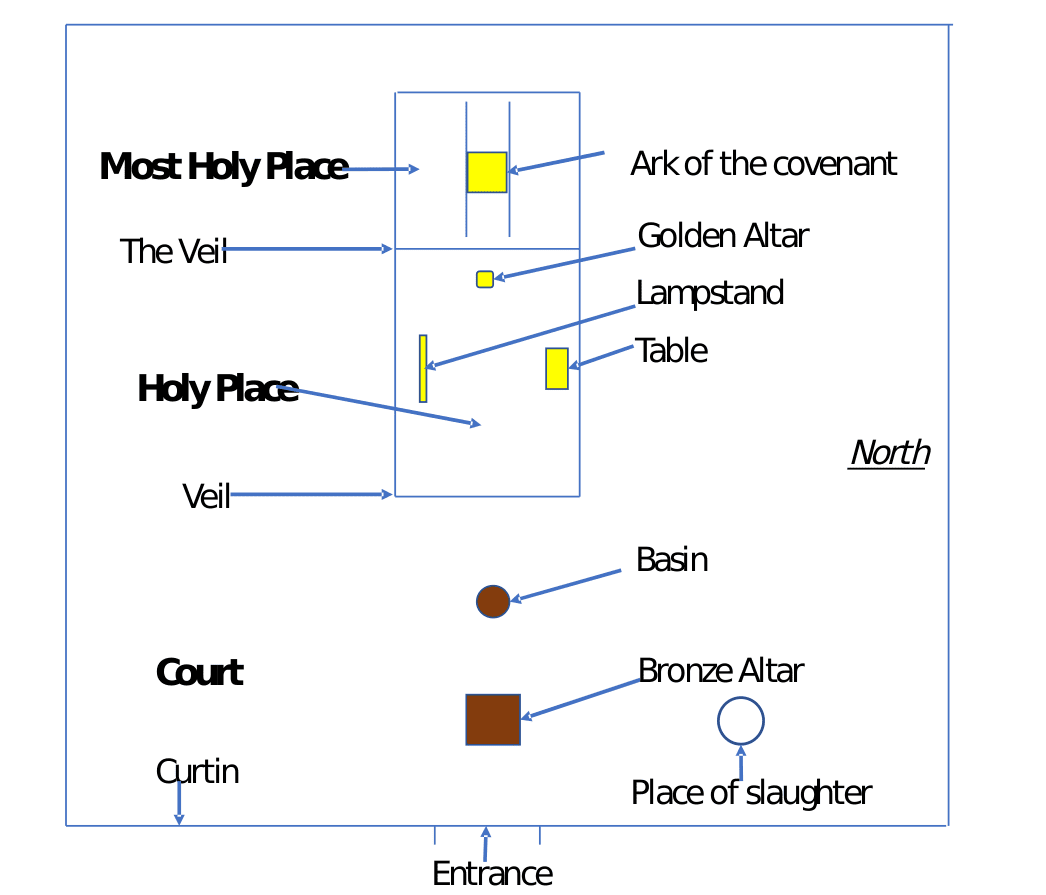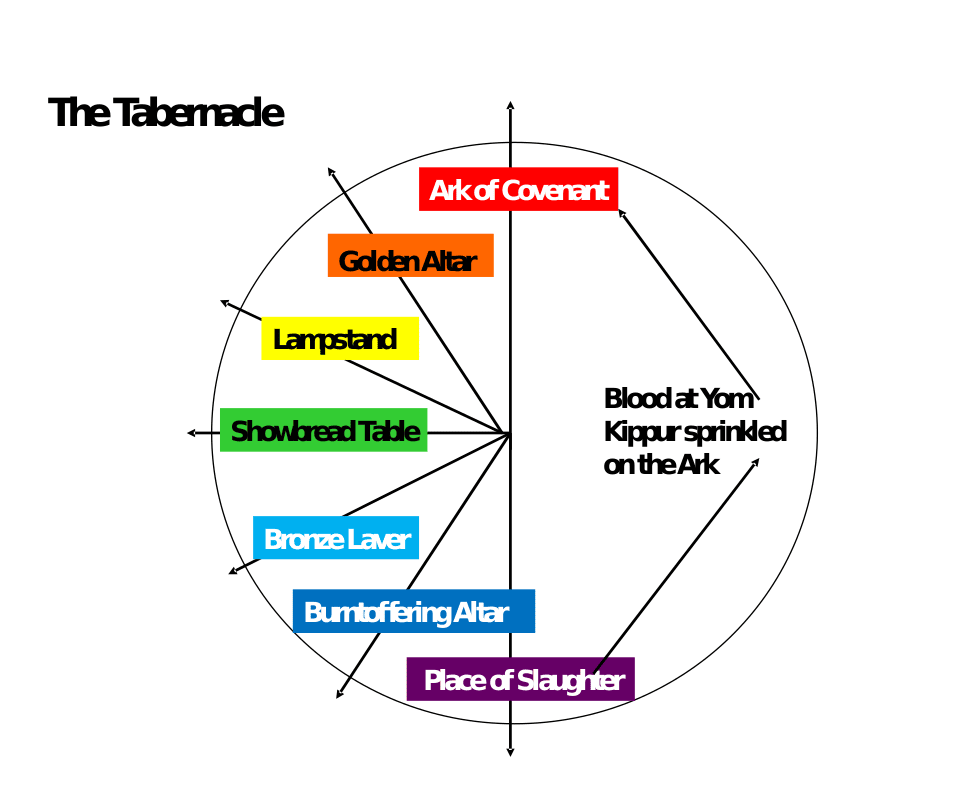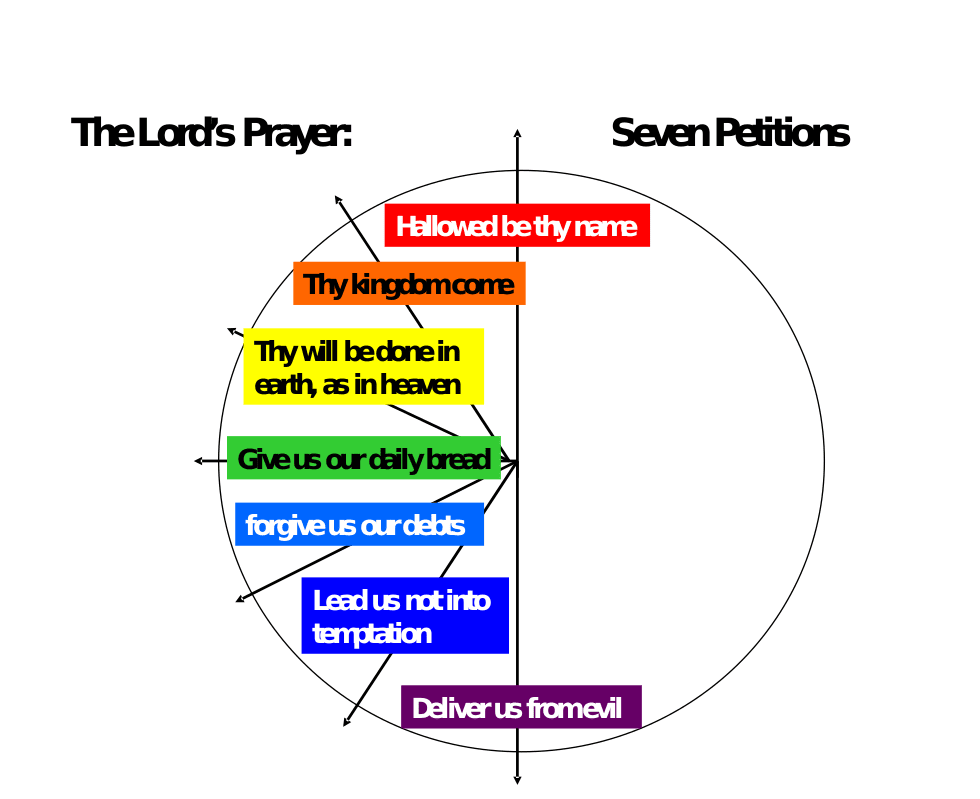The Spectrum of Spiritual Themes in the Tabernacle and in the Church
Hartmut Ising
The sanctuary in the desert
When God had freed his people from Egypt and had led them into the Sinai desert, he spoke to his people by Moses:
Ex.25,8
Let them make me a sanctuary; that I may dwell among them.
God loves his people, so his goal is to live in their midst. The construction of the sanctuary served this wonderful goal. However, God did not simply create the sanctuary through a miracle; the people should build it – not according to their own ideas, but according to God's blueprint:
Ex.25,9
According to all that I show you, after the pattern of the tabernacle, and the pattern of all the furnishings of it, even so shall you make it.
Let us first of all visualize the situation in which God gave his people this order and had it carried out. On Sinai, God, through his servant Moses, had tried to win Israel's trust and given them a wonderful promise:
Ex.19,3-6
Moses went up unto God, and the LORD called unto him out of the mountain, saying, Thus shall you say to the house of Jacob, and tell the children of Israel; You have seen what I did unto the Egyptians, and how I bore you on eagles' wings, and brought you unto myself. Now therefore, if you will obey my voice indeed, and keep my covenant, then you shall be a special treasure unto me above all people: for all the earth is mine: And you shall be unto me a kingdom of priests, and a holy nation. These are the words which you shall speak unto the children of Israel.
Israel should be God's special property, lifted out of all peoples. The word used here also means “special treasure” and is used six times in the OT with reference to Israel.
However, when the Lord revealed something of his power and glory to the people, their reaction was determined by fear of death – there is no trust in God in their words:
Ex.20,18-20
And all the people saw the thunderings, and the lightnings, and the noise of the trumpet, and the mountain smoking: and when the people saw it, they moved, and stood far off. And they said unto Moses, Speak you with us, and we will hear: but let not God speak with us, lest we die. And Moses said unto the people, Fear not: for God has come to prove you, and that his fear may be before your faces, that you sin not.
The loving wooing of God for trust and obedience to faith along the lines of Abraham thus remained unanswered.
Ex.24,3
And Moses came and told the people all the words of the LORD, and all the ordinances: and all the people answered with one voice, and said, All the words which the LORD has said will we do.
No trace of trust and love for the Lord can be seen in this answer either; nevertheless, the Sinai covenant was now in force, sealed with the blood of a sacrificial animal, for the people had promised to keep the Ten Commandments, the centerpiece of the covenant.
God's loving wooing for Israel's trust in the time of Moses and Jesus Christ is compared in Table 1.
Table 1 God's goal, a covenant of love
| Intermediary: | Moses | John the Baptist |
Bridegroom: | The LORD, God of Israel (Ez.16,7-8; Hos.2,21-22) | Jesus Christ (Joh.3,27-30) |
Foundation: | Old Covenant (Ex.24,7-8) Faithfulness promised by Israel | New Covenant (Jer.31,31-34) Forgiveness |
Central part: | 10 commands on tables of stone | God’s law written on the heart |
| Mediator: | Moses (2.Mo.20,18-19) | Jesus Christ (1.Tim.2,5; Heb.12,24) |
But because the people lacked the strength of their father Abraham's faith, this promise was broken after only a few weeks. The people asked for an image of the god and thereby broke the second commandment.
Ps.106,20
& 23 Thus they changed their glory into the image of an ox that eats grass.
23 Therefore he said that he would destroy them, had not Moses his chosen stood before him in the breach, to turn away his wrath, lest he should destroy them.
God forgave Israel that they had broken the covenant, but had Moses had to tell them that because of their stubbornness, God would not go up to the promised land in their midst.
Ex.33,4
When the people heard these evil tidings, they mourned: and no man did put on him his ornaments.
Israel thus showed that the closeness of their God was a matter close to their hearts. The faithful God then took pity on his people. He promised to move with them and they were allowed to build the sanctuary.
Vessels and facilities of the sanctuary
We now want to look at the meaning of the sanctuary's vessels and facilities. Since there are several good books on this subject, only one point that has not been considered before will be dealt with here. The place where the animals were slaughtered was just as important for worship in the sanctuary as the six vessels, the arrangement of which is shown in Fig. 1.
The place where the sacrificial animals had to be slaughtered had been precisely determined by God:
Lev.1,11
And he shall kill it (the sacrificial animal) on the north side of the altar before the LORD
No special precautions were required to dispose of the sacrificial blood during the desert journey. At the Temple in Jerusalem, on the other hand, an elaborate underground disposal system was required because of the large amounts of blood shed at Passover.
Spiritual viewing directions corresponding to the meaning of the vessels and facilities
In the following we want to deal with the spectrum of the meanings of these seven devices for worship. The meaning of the various worship topics will be symbolized by a spiritual direction of view. The three main topics and directions are:
Holiness od God Ark of the covenant vertically upwards
Human needs showbread table horizontal
Sin Place of slaughtering vertically downwards

Fig.1 Layout of the sanctuary in the desert with the vessels and the place of slaughter for the sacrificial animals
By superimposing the main directions 1 and 2 or 2 and 3, the other viewing directions are created, which symbolize the meanings of the other vessels - cf. Fig.2.
This results in the following seven directions of view of the spiritual topics:
1) Ark of the Covenant – God's holiness – vertically upwards
2) The golden incense altar contained both the divine component, the incense offering that rose to God's delight, and the human component the sacrificing priest. However, since the altar was used to offer incense which pleased God, the vertical, upward component predominated in the symbolism chosen here.
3) The light of the golden lampstand reflected God's nature, which illuminates the darkness of this world. The lampstand essentially served to illuminate the sanctuary on earth; therefore, the earthly – horizontal component predominated here
4) Showbread table – human needs – horizontal
5) The bronze basin – made from the mirrors of the serving women (Ex.38,8) – was used for daily cleaning of the priests. Here the priestly service – the horizontal component – was in the foreground. To wash away the daily impurities – vertical component down – the washing was enough. This reminds us of the words of Jesus Christ to Peter: Joh.13,10 Who is bathed does not need to wash, except for the feet, but is completely pure.

Fig.2 Spiritual directions of view, corresponding to the spectrum of meaning of the vessels and facilities for worship.
6) All or part of the sacrificial animals were burned on the bronze burnt-offering altar.
Animal sacrifices were compulsory when the priests were officially inaugurated, as were other sacrifices. During the ordination, a small part of the sacrificial blood was also put on the horns of the altar (Ex. 29,12). In the foreground was the death of the sacrificial animal and the bloodshed, without which no forgiveness of sins is possible (Heb. 9,22). But since it was a matter of cleaning people and giving them the opportunity to live a sacred life in this world, the vertical component is also present in addition to the predominantly downward component.
7) Place of slaughter – sin – vertically downwards
Now we will look at the meanings of the spiritual perspectives in the light of the New Testament. Heb.9,22 shows us the meaning of the shed sacrificial blood (7): No forgiveness happens without bloodshed. But since the blood of animal sacrifices could not make atonement (Heb.10,4), forgiveness can only be given through the blood of Jesus Christ.
Part of the sacrificial blood was sprinkled onto the altar of burnt offerings (6). In Heb.9,14 we read: How much more will the blood of Christ ... purify your conscience. The cleared conscience is represented and explained in the NT by white clothes (Rev.7,14): They made their clothes white in the blood of the lamb. In Rev.6,9-11, John sees the souls of martyrs under the altar of burnt offerings in heaven, who are clothed in white garments. This emphasizes the connection between the cleared conscience and the altar of burnt offerings.
For life in the service of the Lord it is also necessary to wash the body with pure water (Heb.10,22). This was made possible in the tabernacle by the bronze basin (5). This washing begins with the bath of rebirth (Tit.5.3) and then continues, just as the priests had to wash before entering the sanctuary. This reminds us of the words of our Lord Jesus Christ to Peter: John 13,10 Who is bathed does not need to wash, except for the feet, but is completely pure.
The showbread on the golden table (4) were represented in the sanctuary before God, but in contrast to the offerings, they were eaten entirely by the priests. A parallel from the New Testament is the fourth petition in our Lord's prayer: Give us this day our daily bread. (Mt.6,11).
The golden lampstand (3) is reminiscent of our Lord Jesus, who walks in the middle of seven lampstands (Rev.2,1). In the New Jerusalem (Rev.21,23): the glory of God illuminates it, and its lamp is the Lamb.
The golden incense altar (2) stood in the Holy place, but it belonged to the Most Holy place (Heb.9,3-4): Behind the second veil, the tabernacle which is called the Holiest of all; Which had the golden censer, and the ark of the covenant. The connection of the incense with the prayers of the saints is shown in Rev.8.3-5 clearly: Another angel came and stood at the altar, having a golden censer; and there was given unto him much incense, that he should offer it with the prayers of all saints upon the golden altar which was before the throne. And the smoke of the incense, which came with the prayers of the saints, ascended up before God out of the angel's hand. And the angel took the censer, and filled it with fire from the altar, and cast it into the earth: and there were voices, and thunderings, and lightnings, and an earthquake.
The ark of the covenant (1) was covered by the mercy seat. The Greek word which is translated “mercy seat” in Heb.9,5 occurs a second time in Rm.3,25: Whom God has set forth to be a propitiation through faith in his blood. Rev.11,19 describes how John sees the heavenly original of the ark: The temple of God was opened in heaven, and there was seen in his temple the ark of his covenant.
The circle of worship themes therefore begins with God's holiness, leads through human needs and ends with the atonement of guilt and sin. This circle was closed once a year, on the great day of atonement, Yom Kippur, in that the high priest brought sacrificial blood from the place of slaughter to the Most Holy place and sprinkled it on the ark (Lev.16,14).
The spectrum of spiritual themes
The sevenfold spectrum of meaning has a physical parallel in the spectrum of white light. According to Newton, seven spectral colours are distinguished: red, orange, yellow, green,
blue, indigo, violet. These colours merge continuously. In principle, one could differentiate between any number of colours. Newton named the above mentioned seven colours. The visible light spectrum contains all*) colours perceptible to the human eye.
If all spectral colours are available without gaps and in a balanced intensity, by superimposition white light is produced. But if from the white light the short-wave colour range blue, indigo and violet is weakened, this creates a red discoloration. This can be seen at sunrise and sunset. Deep purple hues can no longer be distinguished from black in the evening glow.
The same applies to the range of meanings of spiritual topics. Optimal spiritual discernment and life are only possible if all spiritual areas are balanced in a church. If sin is no longer an issue in a church, there is a serious danger.
But the area of God's holiness, which is independent of any human component, is also increasingly neglected. For example, the worship of God is sometimes replaced by thanks for God's practical help. Of course, thanks is good and important and must have a place in every church. However, since we give thanks for our experiences, the spiritual perspective is not directed vertically upwards, but also contains the horizontal component. In this way, an important spiritual area can gradually be neglected and finally disappear completely.
We should keep in mind that Moses after his 40-year school of humility, had to learn as the first new lesson to respect the holiness of God (Ex.3,4-5). The ark serves only for the holiness of God without any human component.
The topic of holiness and worship of God has a very special meaning in worship. We should also remember that before the destruction of the first temple, the glory of God left the temple and that in the second temple the Most Holy place was empty. – We want to ask us ourselves whether there may be a sad parallel to the current development in Christian communities.

Fig.3 Spiritual viewing directions of the seven petitions in the Lord’s prayer
The range of meanings of worship topics shown here is not only to be found in Old Testament worship. First of all, we find clear parallels in the New Testament in the seven petitions in the Lord's Prayer (Mt.6,9-13). The request: "Hallowed be thy name" contains no human component. – The viewing direction is directed vertically upwards. The fourth petition: "Giveus our daily bread", is only about human concerns – the horizontal direction of view. The direction of the seventh petition: “Deliver us from evil” is directed vertically downwards. All other petitions represent a direction of view that lies between these three main directions.
We also find these viewing directions in the Letter to the Ephesians. Paul begins in the first chapter, verse three, with an impressive hymn praising the glory of God. The letter ends with the spiritual armour for the struggle with the forces of evil (Eph.6,10-20). The horizontal, human level is represented in Chap. 4 by the admonition to unity: Be eager to preserve the unity of the spirit through the bond of peace (Eph.4,3). The other directions of view are not quite as clear, but can also be seen.
The spectrum of these seven spiritual topics and perspectives is of great importance in the Old and New Testaments. That is why it is so important for us that the entire spectrum of spiritual topics in teaching and practice is given a balanced space in our churches.
Annotation
*) The visible spectrum has continuations in the ultraviolet and infrared range that are invisible to our eyes. While we feel the infrared radiation pleasantly as heat, we do not immediately feel the ultraviolet radiation. As a long-term consequence, however, the risk of skin cancer increases; intensive exposure of the eyes can lead to serious eye damage and even blindness. On the spiritual level, the ultraviolet radiation corresponds to the occult area. When people deal with spiritism, they will suffer serious damage for time and eternity. The infrared radiation corresponds to what the apostle Paul suggests in 2.Cor.12,4: How that he was caught up into paradise, and heard unspeakable words, which it is not lawful for a man to utter. So, our hearts can be filled with joy and thanksgiving that there are glories in the world of eternity that are closed to us here and absolutely inconceivably.
(2020-08)